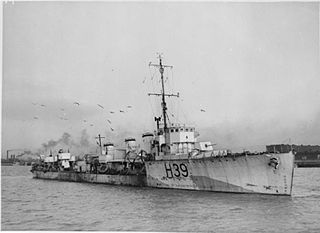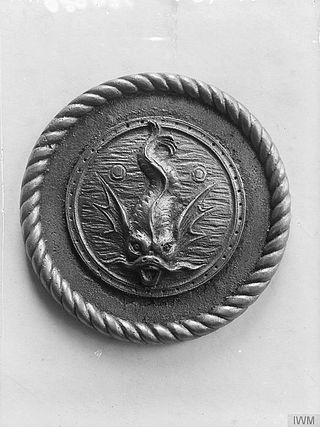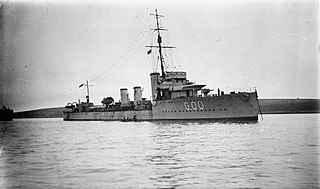
HMS Wolverine was a Beagle-class destroyer of the Royal Navy launched on 15 January 1910. She was built by Cammell Laird at Birkenhead.

HMS Ithuriel was a Marksman-class flotilla leader of the British Royal Navy. Originally to have been named Gabriel, the name was changed before her launch. The ship was built by Cammell Laird at Birkenhead, being launched on 8 March 1916 and entering service in August that year. Ithuriel served with the Grand Fleet during the First World War, leading both a destroyer flotilla and a submarine flotilla. She survived the war, before being sold for scrap on 8 November 1921.

The Marksman class were a class of flotilla leaders built for the Royal Navy. Two each were ordered in the naval programmes of 1913–14 and 1914–15 with a further three being ordered under the Emergency War Programme and all saw service during World War I.

The Blonde-class cruisers were a pair of scout cruisers built for the Royal Navy in the first decade of the 20th century. Upon completion in 1910–11, they served as flotilla leaders for destroyer flotillas of the First Fleet until 1913 when they were assigned to battleship squadrons. When the First World War began in August 1914, they remained with their squadrons as the First Fleet was incorporated into the Grand Fleet, although they changed squadrons over the course of the war. Blonde did not participate in the Battle of Jutland in mid-1916, unlike her sister ship, Blanche, which did, but never fired a shot. They were converted into minelayers the following year, but only Blanche actually laid mines. The sisters were reduced to reserve in 1919 and sold for scrap in 1920–1921.

HMS Meteor was a Thornycroft M-class destroyer that served in the British Royal Navy. Meteor saw extensive service throughout World War I, maintaining continuous operations both as a convoy escort and in harbour protection.

HMS Valentine was a V and W-class destroyer, built in 1917 for the Royal Navy. She fought in both world wars, serving in several capacities. She was heavily damaged by air attack and beached in 1940 near Terneuzen. Her hulk remained there until it was broken up in 1953.

The first HMS Vehement was a V-class destroyer of the British Royal Navy that saw service in World War I. She spent her short career in minelaying operations in the North Sea before striking a mine and sinking in 1918.

HMS Abdiel was a Marksman-class flotilla leader of the Royal Navy, built by Cammell Laird during the First World War. She was converted to a minelayer during construction, commissioning during 1916, and served at the Battle of Jutland. Following the end of the war, Abdiel served in the Baltic during the Russian Civil War. She was sold for scrap in 1936.

HMS Tarpon was a Royal Navy R-class destroyer constructed and operational in the First World War. She is named after the large fish Tarpon; one species of which is native to the Atlantic, and the other to the Indo-Pacific Oceans. Tarpon was built by the shipbuilders John Brown & Company at their Clydebank shipyard and was launched in March 1917 and entered service in April that year.

HMS Nimrod was a Marksman-class flotilla leader of the British Royal Navy. She was built by the Scottish shipbuilder Denny, with construction starting in 1914 and completed in August 1915. She served through the remainder of the First World War. She was sold for scrap in 1921.

HMS Kempenfelt was a Marksman-class flotilla leader of the British Royal Navy. She was built by the Cammell Laird at their Birkenhead shipyard, with construction starting in 1914 and completed in August 1915. She served through the remainder of the First World War. She was sold for scrap in 1921.

HMS Telemachus was a R-class destroyer of the British Royal Navy that took part in the First World War. She was built in 1916–1917 by the Scottish shipbuilder John Brown at their Clydebank shipyard. Telemachus was modified to serve as a minelayer, laying minefields in the German Bight and English Channel to restrict the operation of German submarines. The ship survived the war and was sold for scrap in 1927.
HMS Lark was a Laforey-class destroyer of the British Royal Navy. The Laforey class was the class of destroyers ordered under the Royal Navy's 1912–1913 construction programme, which were armed with three 4-inch (102 mm) guns and four torpedo tubes and were capable of 29 knots. The ship, which was originally to be named Haughty but was renamed before launch, was built by the Scottish shipbuilder Yarrow between 1912 and 1913.

HMS Princess Margaret was a minelayer operated by the British Royal Navy during and after the First World War. She was built by the Scottish shipbuilder William Denny for the Canadian Pacific Railway as a liner to serve on the Pacific West Coast, and as such was powered by geared steam turbines, giving a speed of 23 knots.

HMS Matchless was a Royal Navy Admiralty M-class destroyer. Matchless was built by Swan Hunter from 1913 to 1914 and was completed in December that year. She served through the remainder of the First World War, operating in the North Sea as part of the Harwich Force in the early part of the war and later in the English Channel as part of the Dover Patrol, where she took part in both the First and Second Ostend Raids. Despite being badly damaged by a German mine in 1915 and being involved in several collisions, she survived the war, and was sold for scrap in 1921.
HMS Grenville was a Parker-class flotilla leader of the British Royal Navy. She was built by Cammell Laird during the First World War, being launched on 17 June 1916 and completing on 11 October that year. Grenville served with the Grand Fleet for the rest of the war, which she survived. The ship took part in operations in the Baltic during the Russian Civil War in the winter of 1919–1920, before entering a long period of reserve. She was sold for scrap in December 1931.
HMS Parker was a Parker-class flotilla leader of the British Royal Navy, and the lead ship of her class. She was built by Cammell Laird during the First World War, being launched on 16 August 1916 and completing on 13 December that year. Parker served with the Grand Fleet for the rest of the war, which she survived. The ship was sold for scrap in November 1921.

HMS Seymour was a Parker-class flotilla leader of the British Royal Navy. She was built by Cammell Laird during the First World War, being launched on 31 August 1916 and completing on 30 November that year. Seymour served with the Grand Fleet for the rest of the war, which she survived. The ship was sold for scrap in January 1931.
HMS Saumarez was a Parker-class flotilla leader of the British Royal Navy. She was built by Cammell Laird during the First World War, being launched on 14 October 1916 and completing on 21 December that year. Saumarez served with the Grand Fleet for the rest of the war, which she survived. The ship was sold for scrap in January 1931.
HMS Melpomene was a Medea-class destroyer of the British Royal Navy. She was one of four destroyers, of similar design to the British M-class ordered by Greece in June 1914, which the British purchased during construction owing to the outbreak of the First World War.













